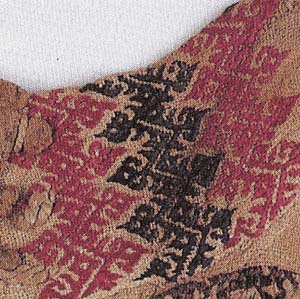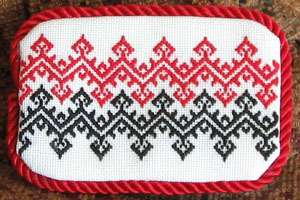Pattern Darning: A Running Stitch in Patterns
Pattern Darning is done with a running stitch. It can go up/down or right/left, but the whole pattern is worked either perpendicular or horizontal. The backside is nearly a mirror image of the front, with the differences being slightly angled threads at the beginning and end of the lines as the thread moves to the next line. The objective is to have blocks of color design with areas of voids, where the fabric becomes a stark contrast to the embroidery.
When sewing the design you work in a row, weaving in and out, completing the full pattern in that row. Then do the next row as a return, but one thread over. Here is a good example of the how-to.
If charted, historic Pattern Darning looks like any other block charted embroidery (i.e. cross stitch). Usually it is done all in one color or different sections may have different colors. A stitch may be over any number of threads with the next part of the pattern in line, also, being over any number of threads. The embroidery thread is used with sufficient plys to create a satin look without the threads being constricted at the holes – a very smooth look. Some of the finer pieces are “over 1” thread.
One of the earliest samplers we have is Egyptian from the last half of the 12th C. It has over 40 blocks of patterns done in Pattern Darning. It was done on linen woven in 19/20 count in red, blue, green and dark brown silk.
There are examples of Pattern Darning from the mid-12th C. through the 16th C. from Egypt and Syria. It was used as decoration on a variety of items of clothing, household linens and furnishings. Many of the designs are geometric, elongated “S’s” or “Z’s”, or birds. There are many variations of each design. A number of pieces are very intricate with multiple bands of designs. Pattern Darning was also used to write out inscriptions of protection from the Koran or blessings from a ruler indicating that the item was a gift.

 This design comes from the collar of a Mamluk tunic front dated between 1460-75 and shown on page 91 of Embroideries and Samplers from Islamic Egypt. The pattern was originally done in blue (faded) and red silk on linen of a 16/15 thread count. On the collar, the bands of red and blue were in overlapping columns alternating in color with 3 bands on each side of the collar front opening.
This design comes from the collar of a Mamluk tunic front dated between 1460-75 and shown on page 91 of Embroideries and Samplers from Islamic Egypt. The pattern was originally done in blue (faded) and red silk on linen of a 16/15 thread count. On the collar, the bands of red and blue were in overlapping columns alternating in color with 3 bands on each side of the collar front opening.
Pattern chated by author and embroidered in silk on linen by author.
See also a full Mamluk sampler at the MFA Boston website - accession number 48.1053
To view a variety of Mamluk Egyptian patterns look here.
Some of the patterns work their way to Europe and are seen in the modelbooks printed in the 16th C. and the samplers of the early 17th C. Of particular note are the “S” and “Z” motifs.
Pattern Darning also appears in medieval textiles in Germany and Iceland. In Germany during the 14th and 15th C., it is part of a white on white style of counted thread satin stitch that is known as Opus Teutonicum. From Iceland, of approximately 1500, there are three altar frontals that have large areas of Pattern Darning in addition to other stitches. There is also a long bed hanging of linen with silk embroidery from the early part of the 17th C.
 The Icelandic patterns are primarily geometric although there are a few birds that look to have stepped off of the Mamluk textiles of Egypt. In one altar frontal, the pattern is of large blocks of intricate interlace patterns done in a variety of colors; including brown, gold, blue/green, and brown/black. On another altar frontal, the patterns are geometric bands and small birds. The patterns in both are executed in wool thread on linen tabby. The bed hanging has both intricate interlacings and the first three verses of the 51st Psalm around the edge. The Icelandic term for Straight Darning is “Glitsaumur” and Pattern Darning is “Skakkaglit”, however, Ms. Gudjonsson notes that they sometimes are used almost interchangeably.
The Icelandic patterns are primarily geometric although there are a few birds that look to have stepped off of the Mamluk textiles of Egypt. In one altar frontal, the pattern is of large blocks of intricate interlace patterns done in a variety of colors; including brown, gold, blue/green, and brown/black. On another altar frontal, the patterns are geometric bands and small birds. The patterns in both are executed in wool thread on linen tabby. The bed hanging has both intricate interlacings and the first three verses of the 51st Psalm around the edge. The Icelandic term for Straight Darning is “Glitsaumur” and Pattern Darning is “Skakkaglit”, however, Ms. Gudjonsson notes that they sometimes are used almost interchangeably.
For more information and Icelandic patterns visit Joyce Miller's site. The squares at the right were done from a pattern on Ms. Miller's site by author in silk on linen.
Bibliography:
A Book of Old Embroidery, by A. F. Kendrick. Published by The Studio, London, 1921.
Embroideries and Samplers from Islamic Egypt, by Marianne Ellis. Published by Ashmolean Museum, University of Oxford, 2001. ISBN 1 85444 135 3.
Tissus D’Egypte, Temoins du monde arabe VIIIc. – XVc. Siecles. Published by Societe Presence du livre, Musee d’art et d’histoire, Geneve, 1993. ISBN 2-908528-52-5.
Traditional Icelandic Embroidery, by Elsa E. Guojonsson. 2nd edition, self published, 2003. ISBN 9979-9202-6-2.
“Icelandic Medieval Embroidery Terms and Techniques” by Elsa E. Gudjonsson, pages 133-143. From Studies in Textile History, edited by Veronika Gervers. Published by Royal Ontario Museum, Toronto, 1977. ISBN 0-88854-192-9.

 This design comes from the collar of a Mamluk tunic front dated between 1460-75 and shown on page 91 of Embroideries and Samplers from Islamic Egypt. The pattern was originally done in blue (faded) and red silk on linen of a 16/15 thread count. On the collar, the bands of red and blue were in overlapping columns alternating in color with 3 bands on each side of the collar front opening.
This design comes from the collar of a Mamluk tunic front dated between 1460-75 and shown on page 91 of Embroideries and Samplers from Islamic Egypt. The pattern was originally done in blue (faded) and red silk on linen of a 16/15 thread count. On the collar, the bands of red and blue were in overlapping columns alternating in color with 3 bands on each side of the collar front opening.  The Icelandic patterns are primarily geometric although there are a few birds that look to have stepped off of the Mamluk textiles of Egypt. In one altar frontal, the pattern is of large blocks of intricate interlace patterns done in a variety of colors; including brown, gold, blue/green, and brown/black. On another altar frontal, the patterns are geometric bands and small birds. The patterns in both are executed in wool thread on linen tabby. The bed hanging has both intricate interlacings and the first three verses of the 51st Psalm around the edge. The Icelandic term for Straight Darning is “Glitsaumur” and Pattern Darning is “Skakkaglit”, however, Ms. Gudjonsson notes that they sometimes are used almost interchangeably.
The Icelandic patterns are primarily geometric although there are a few birds that look to have stepped off of the Mamluk textiles of Egypt. In one altar frontal, the pattern is of large blocks of intricate interlace patterns done in a variety of colors; including brown, gold, blue/green, and brown/black. On another altar frontal, the patterns are geometric bands and small birds. The patterns in both are executed in wool thread on linen tabby. The bed hanging has both intricate interlacings and the first three verses of the 51st Psalm around the edge. The Icelandic term for Straight Darning is “Glitsaumur” and Pattern Darning is “Skakkaglit”, however, Ms. Gudjonsson notes that they sometimes are used almost interchangeably.